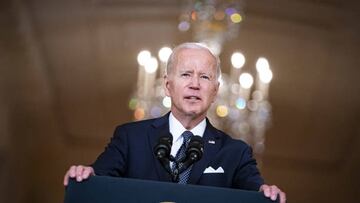Student loan cancellation: Who qualifies and what does one need to do to have the debt cancelled?
Student loan relief is on the way. Here is an overview of what you need to do to see all or some of your debt forgiven.


President Biden addressed the nation on Wednesday to announce that the government will undertake the largest student debt cancellation in US history. Pell Grant recipients and non-grantees will be able to cut $20,000 and $10,000 in student loan debt, respectively, so long as they make under $125,000 a year (250,000 for married couples).
In addition to debt relief, the administration has chosen to extend the student loan moratorium “one more time” through 31 December 2022. The White House made clear this would the last time saying “Borrowers should expect to resume payment in January 2023.”
Some borrowers will be facing significantly lower balances come January, but still many believe this effort falls short of what Democrats promised in 2020.
BREAKING NEWS: The Department of Education will provide up to $20,000 in targeted student debt cancellation to borrowers with loans held by the Department, ensuring that borrowers are not worse off financially due to the pandemic. https://t.co/N4xOnieOaN [🧵 1/7 ] pic.twitter.com/AGyax5x2W8
— U.S. Department of Education (@usedgov) August 24, 2022
What steps need to be taken to have the debt cancelled?
The Department of Education has reported that for the eight million borrowers for which they have personal and financial data on file, the loans will be cancelled automatically. For those who do not believe the department would have their information, a short application in the coming days for users to provide it. To be alerted when the application becomes available, those interested can register for an advisory message to be sent to their e-mail.
The application must be submitted before 31 December 2022.
What other benefits will be offered to borrowers?
The Biden administration’s executive order will also implement a few rule changes at the Department of Education to provide additional relief to low and middle income borrowers.
The main focus is on lowering monthly payments. The new rules would cap what borrowers would be required on a monthly basis to five percent of their discretionary income. The current repayment plan places this cap at 10 percent. The rules also “raise the amount of income that is considered non-discretionary,” to ensure that more of people’s livelihood is protected from the predatory student debt payments.
However, this only applies to undergraduate loans, and excludes those who earned a masters, PdD or attended and medical school. These loans can be just as financially debilitating and ruinous and the administration will continue to face pressure to held those with graduate loans receive some relief.
Additionally, the Department of Education will be able to cancel loans under $12,000 after ten years of payments have been made - this will be down from 20 years until the current rules.
In keeping with my campaign promise, my Administration is announcing a plan to give working and middle class families breathing room as they prepare to resume federal student loan payments in January 2023.
— President Biden (@POTUS) August 24, 2022
I'll have more details this afternoon. pic.twitter.com/kuZNqoMe4I
What about interest?
Related stories
The White House has made an attempt to address the predatory nature of student loan interest rates by implementing a rule that prohibits a borrower, who make their monthly payments, to see their principle balance increase. Some borrowers who had consistently made payments, in some cases for decades, were will accruing debt because their required payment all went to interest. The issues with interest are a major part of this crisis and have perpetrated cycles of debt that have made it hard for millions to escape.
Debt holders wshould be aware that